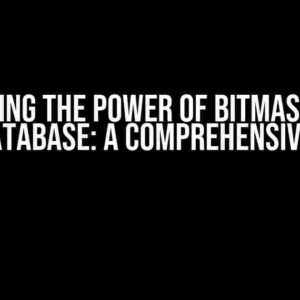In today’s fast-paced digital world, real-time data streaming has become an essential feature for many applications. MongoDB, a popular NoSQL database, provides a powerful tool for handling large amounts of data in real-time. In this article, we’ll show you how to get MongoDB stream real-time data in your front-facing application, enabling you to build dynamic and interactive user experiences.
- Why Real-Time Data Streaming Matters
- Understanding MongoDB Change Streams
- Prerequisites and Setup
- Step 1: Create a MongoDB Change Stream
- Step 2: Process Change Documents in Your Application
- Step 3: Integrate with Your Front-Facing Application
- Example Use Case: Real-Time Updates for a Social Media Feed
- Tips and Tricks
- Conclusion
Why Real-Time Data Streaming Matters
Real-time data streaming is critical for applications that require instant updates, such as:
- Live updates for social media feeds
- Real-time analytics and reporting
- Interactive dashboards and monitoring systems
- Live scoring and updates for sports and gaming applications
- Real-time messaging and collaboration tools
In these scenarios, MongoDB’s change streams feature provides an efficient way to capture and process real-time data changes, enabling your application to respond promptly to updates.
Understanding MongoDB Change Streams
MongoDB change streams are a powerful feature that allows you to capture and process real-time data changes in your database. Here’s how it works:
- Change Stream Opened: Your application opens a change stream, specifying the collection and pipeline to monitor.
- Change Detected: MongoDB detects a change in the monitored collection, such as an insert, update, or delete operation.
- Change Document Created: MongoDB creates a change document, which contains information about the change, including the operation type, document key, and updated fields.
- Change Stream Processor: Your application receives the change document and processes it according to your business logic.
Prerequisites and Setup
Before we dive into the implementation, ensure you have the following:
- MongoDB version 3.6 or later
- A MongoDB collection with data
- A front-facing application (e.g., web app, mobile app, or desktop app)
- A programming language of your choice (e.g., Node.js, Python, Java)
Step 1: Create a MongoDB Change Stream
In your MongoDB shell or using your preferred programming language, create a change stream on the collection you want to monitor:
use mydatabase db.my collection.watch()
This will open a change stream on the `mycollection` collection. You can specify additional options, such as:
db.my collection.watch([], { fullDocument: 'updateLookup' })
This will include the full document in the change document, rather than just the updated fields.
Step 2: Process Change Documents in Your Application
In your front-facing application, you’ll need to establish a connection to your MongoDB instance and create a change stream processor. Here’s an example using Node.js and the `mongodb` package:
const MongoClient = require('mongodb').MongoClient;
MongoClient.connect('mongodb://localhost:27017', (err, client) => {
if (err) {
console.error(err);
return;
}
const db = client.db();
const collection = db.collection('mycollection');
const changeStream = collection.watch();
changeStream.on('change', (change) => {
console.log(change);
// Process the change document here
});
changeStream.on('error', (err) => {
console.error(err);
});
changeStream.on('close', () => {
console.log('Change stream closed');
});
});
In this example, we establish a connection to our MongoDB instance, create a change stream on the `mycollection` collection, and define a processor function to handle incoming change documents.
Step 3: Integrate with Your Front-Facing Application
Once you’ve set up the change stream processor, you can integrate the real-time data with your front-facing application. This may involve:
- Updating the UI with the new data
- Triggering notifications or alerts
- Running analytics or machine learning models on the new data
- Updating caching layers or search indexes
The possibilities are endless, depending on your application’s requirements.
Example Use Case: Real-Time Updates for a Social Media Feed
Let’s say we’re building a social media platform with a real-time feed. We want to update the user’s feed instantly when a new post is added or updated. Here’s an example:
// Client-side code
const feedContainer = document.getElementById('feed-container');
// Change stream processor
changeStream.on('change', (change) => {
if (change.operationType === 'insert') {
const newPost = change.fullDocument;
const postHTML = `
<div>
<h2>${newPost.title}</h2>
<p>${newPost.content}</p>
</div>
`;
feedContainer.innerHTML += postHTML;
}
});
In this example, we update the user’s feed in real-time as new posts are added, creating a dynamic and engaging user experience.
Tips and Tricks
Here are some tips to keep in mind when working with MongoDB change streams:
- Resilience**: Change streams can fail or disconnect. Implement retry logic and error handling to ensure your application remains resilient.
- Performance**: Change streams can be resource-intensive. Optimize your pipeline and processing logic to minimize performance impacts.
- Scalability**: Design your application to scale horizontally, using load balancers and clustering to handle high traffic and large datasets.
- Security**: Ensure your change stream processor and application follow secure coding practices, such as input validation and authorization.
Conclusion
In this article, we’ve shown you how to get MongoDB stream real-time data in your front-facing application. By leveraging MongoDB’s change streams feature, you can build dynamic, interactive, and engaging user experiences that respond instantly to data updates. Remember to optimize your pipeline, process change documents efficiently, and integrate with your application’s requirements. Happy coding!
| Keyword | Frequency |
|---|---|
| Get MongoDB Stream Real Time data | 5 |
| MongoDB Change Streams | 4 |
| Front-Facing Application | 3 |
| Real-Time Data Streaming | 2 |
Here are 5 Questions and Answers about “Get MongoDB Stream Real Time data in the front facing” in HTML format with a creative voice and tone:
Frequently Asked Question
Get the scoop on streaming real-time MongoDB data to your front-facing application! Check out these FAQs to get started!
How do I enable real-time data streaming from MongoDB?
To enable real-time data streaming from MongoDB, you’ll need to use the Change Streams feature, which is available in MongoDB 3.6 and later versions. Change Streams allows you to listen to changes in your MongoDB data in real-time. You can use the MongoDB Node.js driver or MongoDB Atlas to set up Change Streams.
What is the best way to handle real-time data streaming in my front-facing application?
When it comes to handling real-time data streaming in your front-facing application, it’s essential to use WebSockets or WebRTC to establish a bi-directional communication channel between the client and server. This allows you to push updates to the client in real-time, ensuring a seamless user experience.
Can I use MongoDB’s built-in aggregations to process real-time data streams?
Yes, you can use MongoDB’s built-in aggregations to process real-time data streams. MongoDB’s aggregation framework allows you to transform, filter, and group data in real-time, making it an ideal solution for processing large volumes of data streams.
How do I ensure data consistency and integrity when streaming real-time data from MongoDB?
To ensure data consistency and integrity when streaming real-time data from MongoDB, use transactions to atomicity ensure that updates are applied consistently across all nodes. Additionally, implement data validation and normalization techniques to ensure data quality and consistency.
What are some best practices for optimizing real-time data streaming from MongoDB?
To optimize real-time data streaming from MongoDB, use connection pooling, caching, and batching to reduce the load on your MongoDB instance. Additionally, use indexes to improve query performance, and implement data filtering and compression to reduce data size and latency.


